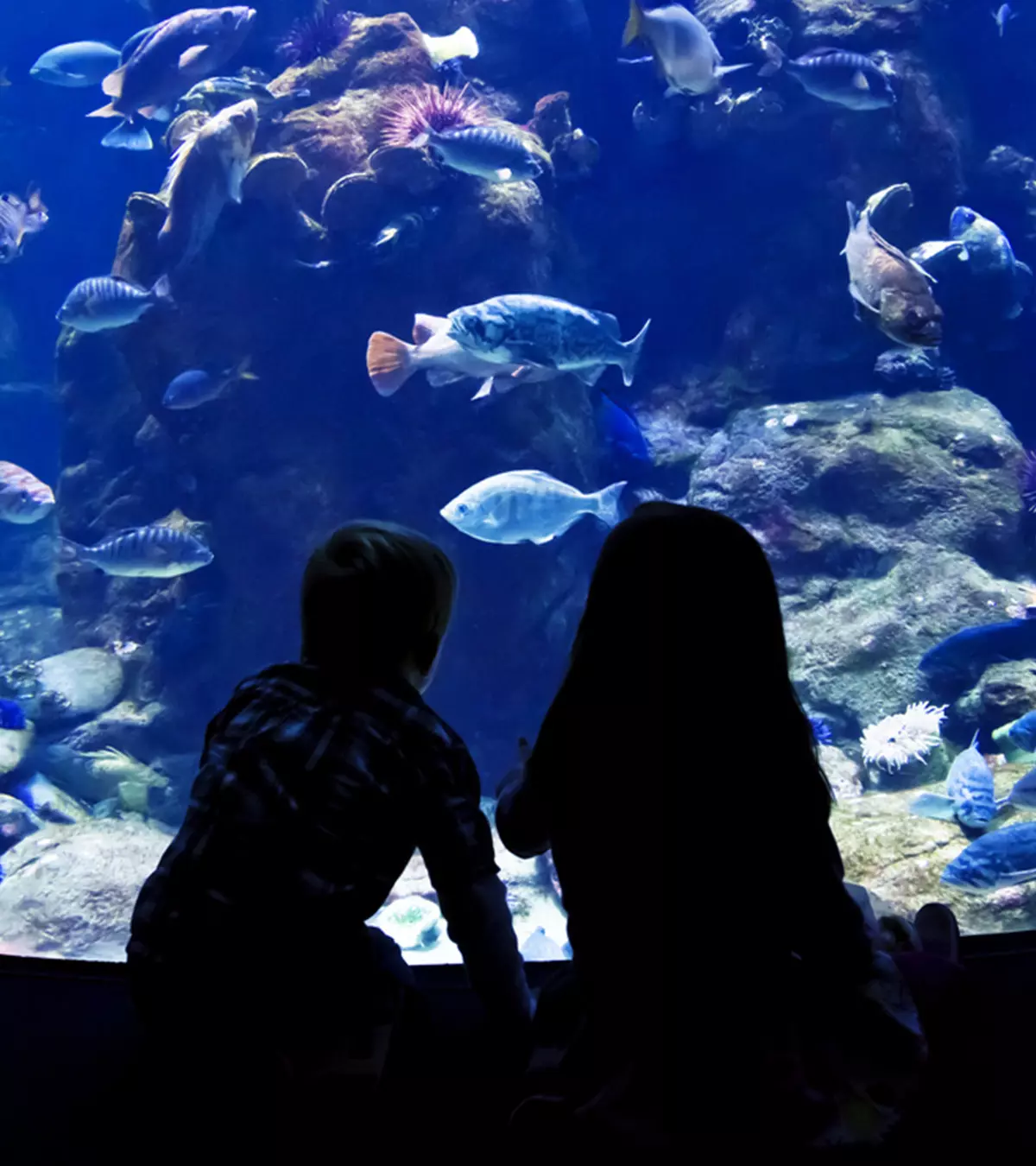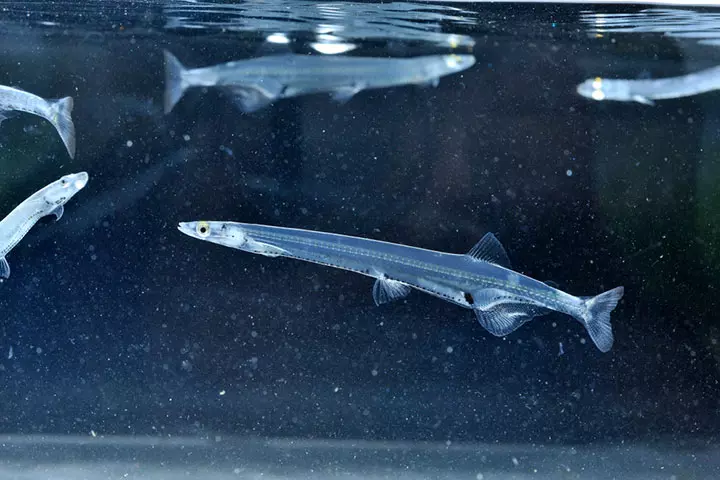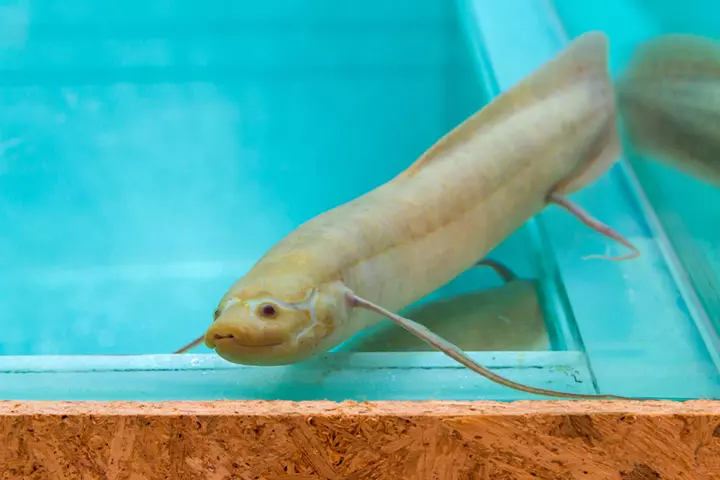
Image: ShutterStock
Fish can pique curiosity in children. If your little ones want to know more about them, our post on facts about fish for kids can be interesting. After all, these wonderful water creatures move so swiftly that even adults find it fascinating. Also, they are an important part of our environment and ecosystem, and children need to know their role in our lives. So introduce your child to the world of fish and make them understand some of the coolest facts about these underwater marvels.

Key Pointers
- Fish fascinate small children because they are usually inquisitive about how these amazing creatures breathe underwater.
- Fish facts can help children learn more about these underwater beings.
- Conduct a fun quiz to test their knowledge of fish.
Interesting Information About Fish For Children
Anatomy of a fish
There are more than 35,000 fish species in the world (1). They come in different shapes, colors, sizes, and forms. However, they all have these body parts.

- Eyes: A fish has no eyelids, and its eyes stay open at all times, even while sleeping. The shape of a fish’s eyes depends on its habitat and what it feeds on. For instance, predator fishes have forward-facing eyes, while prey fishes have eyes on the sides of their heads. Some fish have color vision, and a few can see in UV light (2).
- Mouth: Like its eyes, a fish’s mouth shape also varies from one fish type to another. This variation depends on what they eat and how they hunt (3). Their teeth are also of different shapes depending on their diet. And based on the species, the teeth can be located in the lips, mouth, jaws, tongue, or even throat! (4)
- Gills: Unlike other mammals, fishes breathe through their gills (2). The gills of a fish have three parts—gill arch, gill filaments, and gill rakers. The gill arch supports the gill filaments. The gill filaments absorb oxygen from the water. A continuous passage of water from the fish’s mouth to the gills and then back to the water body helps the fish breathe.
The gill rakers are comb-like structures that filter food from the water before it passes to the gill for oxygen absorption. It helps keep the food inside the mouth while the water moves.
- Vertebral column: Fishes have a simple skeletal structure wherein the skeleton supports the connective tissues and protects the organs. The vertebral column or backbone isn’t hard but stiff and is made of small bones called vertebrae. These small bones have holes from which the spinal cord passes. The spaces between the vertebrae allow the backbone to bend (2).
- Fins: Fins are delicate structures composed of tiny bones or cartilage covered by skin. The primary function of the fins is to stabilize the fish while it is swimming. But, in some cases, they also offer protection. Most fishes have two kinds of fins—median (dorsal, caudal, and anal fin) and paired (pelvic and pectoral fins) (2).
- Lateral line: Most fishes have a lateral line. It is an anatomical structure with holes that runs the entire length of the fish. Its prime function is to sense vibration in the water and locate predators, prey, or obstacles (2).
- Scales: Most fishes have scales that protect their skin. There are four different types of scales—placoid, ganoid, cycloid, and ctenoid scales (2).
Where do fish live?
Lakes, ponds, streams, rivers, seas, and oceans—fishes live in all aquatic habitats. However, different fish live in different places. For instance, cod, tuna, anglerfish, clownfish, and halibut live in saltwater, whereas trout, minnow, guppy, catfish, carp, sturgeon, pike, etc. live in freshwater (5).
Some fishes, such as salmon, anchovy, flounder, and striped bass, can live in both freshwater and saltwater habitats and are known as anadromous fish. Catadromous fish, such as most eels, on the contrary, live in freshwater but move to saltwater to reproduce. Furthermore, some fish, such as sea trout, sea bass, and muller, live in estuaries.
An estuary is a water body where freshwater meets seawater, and the resulting water is known as brackish. A fish’s aquatic habitat depends on factors such as water salinity, pH, temperature, and dissolved oxygen.
30 Facts About Fish For Children
Read this section to get some interesting and fun fish facts that you could share with your children.
- Most sharks have dual-shade bodies. It means their body’s upper side (dorsal side) is darker than the lower side (later side). This unique characteristic makes them hard to detect (6).
- Fishes are one of the oldest survivors on Earth. They have inhabited the planet for more than 450 million years! (7)
- Did you know the sailfish is considered to be the fastest fish in the ocean? It can swim at speeds of up to 70mph (8).
- Now, any guesses what the slowest fish is? Well, a seahorse is the slowest fish. It swims so slow that if you don’t pay attention, you can’t tell it is swimming (9).
- Fish eat fish, but did you know some fishes eat plants too? Rabbitfish, unicornfish, and surgeonfish are some small, herbivorous fishes that eat brown seaweed (10).

- Pufferfish is a unique fish that contains a toxin called tetrodotoxin, which is more poisonous than cyanide (11).
- A fish can get sunburn even when underwater. Yes, you heard it right! Although rare, it can happen in fish farms at high altitudes (12).
- The largest fish is the whale shark Rhincodon typus, which grows up to 50 feet in length (13)
- The smallest fish is the tiny goby, which grows no longer than half an inch (14).
- Up to 51% of the fishes in the world, that is, more than 18,000 different species, live in freshwater (15).
- An electric eel can generate an electric charge of 350-650 volts (13).
- Did you know that Benthic sharks spend their lives in the deepest parts of the ocean without seeing daylight? (5)
- About 3,000 species of fish live in the Amazon River, and 40 percent of these are catfish and characines. (16)

- A tambaqui is a giant, bass-like fish that has sharp teeth. It can eat palm nuts and rubber tree seeds effortlessly (16).
- Humans have 10,000 taste buds on average, but catfish have more than 100,000 taste buds (17).

- Climbing perch is a fish that can breathe and move on land, generally between pools. They use their pectoral fins to move on land (18).
- Have you heard of the famous “Piranha fish” from the movie Piranha? Its reputation is of a gruesome fish that can rip a person into pieces. However, in reality, most piranha species are vegetarians! (16)
- Fish don’t have vocal cords, but they use their other body parts to make sounds. Gulf corvina is the loudest fish (19).
- Contrary to general perception, jellyfish and starfish aren’t fish as they don’t have gills, scales, and backbones (20).
- A flying fish can glide for up to 650 feet (200 meters) (21).

- Can you name two fishes that swim vertically?
Almost all fishes swim horizontally in the water. However, seahorses and shrimp fish swim vertically (22).
- The shark is one of those fishes that can’t stay afloat as they lack an air bladder (23).
- There are nearly 450 species of fish that can change their sex and even fertilize their egg if there’s no partner from the opposite sex (24).
- Chalk bass is a fish that can change its sex up to 20 times a day! (25)
- A male bangaii cardinalfish can hold eggs and babies in its mouth (mouthbrooding) until they are ready to swim independently. Until then, it doesn’t eat (7).

- Did you know that Antarctic fishes have antifreeze in their blood that lets them live in temperatures as low as minus degrees Celsius? (26)
- It’s a widely held idea that fish can’t live in warm water, but some species of pupfish can live in hot springs with a temperature of over 114 degrees Fahrenheit (27).
 Quick fact
Quick fact- A Pacific salmon changes its color to attract a mate. After mating, it returns to its home stream, where it lays eggs. During this process, they stop eating and lose all their energy to return to the oceans and die (28).

- The West African lungfish can survive on land without water if needed because it has both gills and lungs (29).
- Did you know that bottlenose dolphins sleep with one-half of their brain active and one eye open? It’s believed they do this to stick together and keep an eye on predators.(30)
Fish is essential to aquatic diversity and has been integral to human existence. Learn exciting facts about fish for children from this video.
Frequently Asked Questions
1. Can fish survive in milk?
Milk contains around 87% of water (31). However, due to the difference in the levels of dissolved oxygen and acidity of milk, it would not be able to support the life of a fish.
2. What is the first phase of fish production?
The first phase of fish production or aquaculture occurs in the hatchery. Here, the fish are bred, hatched, and raised. These fish are then transferred to the farm when they have grown enough (32).
3. Do fish have feelings?
Fish demonstrate behaviors and physiological reactions that imply the possibility of them having emotions and subjective experiences. Although the specific nature and depth of their feelings are still uncertain, scientific studies suggest that fish can experience stress, anxiety, pain, and potentially other emotional states (35).
4. Do fish ever get thirsty?
Fish do not experience thirst in the same way that mammals do. Unlike mammals, fish live in water and obtain the necessary hydration through their aquatic environment, absorbing water through their skin and gills and maintaining their internal balance (36).
5. What can kids do to learn more about fish?
To help your kids learn more about fish, you can teach them how to draw and color fish to explain fish anatomy. Making fish origami can also be an engaging activity. You can take children to an aquarium or explore local waterways to introduce them to different varieties of fish and their specific traits. Moreover, reading fish-themed books and watching animated movies and documentaries on fish can also be educational and entertaining.
Fishes are so stunning that children can keep looking at them for their vibrant colors and shapes. The fascination increases as you tell them more about the fish anatomy and different species. The more fish facts you share with them, the more they like to know. It is good for young minds to learn about water creatures as they are integral to our ecosystem. Hence, keep feeding your little ones with more interesting water animal information for kids and help them connect with nature right from their foundation years. DBSenk, a mother of four, shares how her child learned and remembered facts she taught her about fish. She says, ”Roxie came and talked about the facts and names of different fish, then I showed them simple drawings to reinforce these facts. After that, we read the information book, noticing where Roxie learned her facts. After reading we tried to remember all the facts Roxie shared with us. Then I asked them to draw and write about 3 kinds of fish (i).”
Infographic: Intriguing Fish Facts For Kids
Fishes are those aquatic living beings that children are most fascinated with. If you want your child to learn more about various kinds of fish and their unique features, this infographic provides interesting facts about fish to astound them and leave them wanting to know more.
Some thing wrong with infographic shortcode. please verify shortcode syntax
Illustration: Informative Facts About Fish For Kids Parts & Images

Image: Stable Diffusion/MomJunction Design Team
Personal Experience: Source
MomJunction articles include first-hand experiences to provide you with better insights through real-life narratives. Here are the sources of personal accounts referenced in this article.
i. The Ocean.https://dbsenk.wordpress.com/2011/04/11/the-ocean/
References
- Fish FAQ.
https://www.floridamuseum.ufl.edu/discover-fish/fish/faq/ - Structure and Function – Fish.
https://manoa.hawaii.edu/exploringourfluidearth/biological/fish/structure-and-function-fish - Mouth Types.
https://www.floridamuseum.ufl.edu/discover-fish/fish/anatomy/mouth-types/ - Tooth Types & Patches.
https://www.floridamuseum.ufl.edu/discover-fish/fish/anatomy/tooth-types-patches/ - Where Fish Live.
https://sealsanctuary.co.uk/wherefishlive_pupil.pdf - Fish Adaptions.
https://www.floridamuseum.ufl.edu/discover-fish/fish/adaptions/ - Fun Facts – Fish Facts.
https://nmssanctuaries.blob.core.windows.net/sanctuaries-prod/media/archive/education/voicesofthebay/pdfs/funfacts.pdf - Sailfish.
https://oceana.org/marine-life/sailfish/ - 7 Wild Facts You May Not Know About Seahorses.
https://oceanconservancy.org/blog/2018/12/10/7-wild-facts-may-not-know-seahorses/ - Plant-eating fish.
https://spccfpstore1.blob.core.windows.net/digitallibrary-docs/files/89/89be346cf7b9cc83be17ef32d0614a5a.pdf?sv=2015-12-11&sr=b&sig=Tzr2fA%2BtOAR6AXk44WOPXxGsGZ8WKcBKy6lhVxKVJPU%3D&se=2025-09-06T08%3A44%3A16Z&sp=r&rscc=public%2C%20max-age%3D864000%2C%20max-stale%3D86400&rsct=application%2Fpdf&rscd=inline%3B%20filename%3D%22Anon_13_ISFC_29_Plant_eating_fish.pdf%22 - Advisory on Puffer Fish.
https://www.fda.gov/food/alerts-advisories-safety-information/advisory-puffer-fish - Sunburn In Fish.
https://animalbiosciences.uoguelph.ca/aquacentre/information/articles/sunburn-in-fish.html - Fish FAQ.
https://www.floridamuseum.ufl.edu/discover-fish/fish/faq/ - Fun Facts about Fascinating Fish.
https://www.fisheries.noaa.gov/national/outreach-and-education/fun-facts-about-fascinating-fish - One-third of freshwater fish face extinction and other freshwater fish facts.
https://www.worldwildlife.org/stories/one-third-of-freshwater-fish-face-extinction-and-other-freshwater-fish-facts - Fish life in the Amazon rivers.
https://wwf.panda.org/discover/knowledge_hub/where_we_work/amazon/about_the_amazon/wildlife_amazon/fish/ - Amazing Animal Senses.
http://faculty.washington.edu/chudler/amaze.html - Climbing Perch Anabas testudineus Bloch 1792.
https://fishesofaustralia.net.au/home/species/2674 - Scientists Crown World’s Loudest Fish.
https://www.science.org/content/article/one-loudest-underwater-sounds-made-animal-you-wouldn-t-expect - Are starfish really fish?
https://oceanservice.noaa.gov/facts/starfish.html - Flying fish.
https://www.nwf.org/Educational-Resources/Wildlife-Guide/Fish/Flying-Fish - The Fascinating Things About Creatures That Swim.
https://blog.nwf.org/2011/03/the-fascinating-things-about-creatures-that-swim/ - Myths About Sharks and Rays.
https://www.amnh.org/explore/news-blogs/sharks-rays-myths - About 450 species of fish can change their sex.
https://scienceinpoland.pl/en/news/news%2C27385%2Cabout-450-species-fish-can-change-their-sex.html - These Fish Swap Their Sex Up to 20 Times a Day.
https://www.nationalgeographic.com/animals/article/sex-swapping-fish-chalk-bass-hermaphrodites - Fish Antifreeze Proteins.
https://www.nsf.gov/pubs/1996/nstc96rp/sb3.htm - These Animals Thrive in the Hottest Places on Earth
https://www.nationalgeographic.com/animals/article/animals-heat-deserts-hottest-foxes - Why do salmon change color and die after they spawn?
https://www.usgs.gov/faqs/why-do-salmon-change-color-and-die-after-they-spawn?qt-news_science_products=0#qt-news_science_products - West African Lungfish.
https://education.nationalgeographic.org/resource//media/west-african-lungfish/ - Top 10 Facts About Dolphins.
https://www.wwf.org.uk/learn/fascinating-facts/dolphins - Definitions.
https://www.idfa.org/definition#:~:text=Milk%20is%20approximately%2087%20percent%20water%20and%2013%20percent%20solids. - What Is Aquaculture and Why Do We Need It?
https://www.globalseafood.org/blog/what-is-aquaculture-why-do-we-need-it/ - Jawless Vertebrates.
https://www.digitalatlasofancientlife.org/learn/chordata/jawless-vertebrates/ - 5 Facts About Mudskippers.
https://oceanconservancy.org/blog/2025/05/12/5-facts-mudskippers/ - Do fish have feelings?
https://lighthouse.mq.edu.au/article/2018-stories/do-fish-have-feelings#:~:text=Like%20the%20rest%20of%20the,that%20you%20and%20I%20do. - Do Fish Get Thirsty? Understanding the Hydration Needs of Aquatic Animals
https://www.americanoceans.org/facts/do-fish-get-thirsty/
Community Experiences
Join the conversation and become a part of our nurturing community! Share your stories, experiences, and insights to connect with fellow parents.
Read full bio of Dr Rebbecca Wilcox
Read full bio of Bharathi V
Read full bio of Harshita Makvana
Read full bio of Kavita Kankani


















